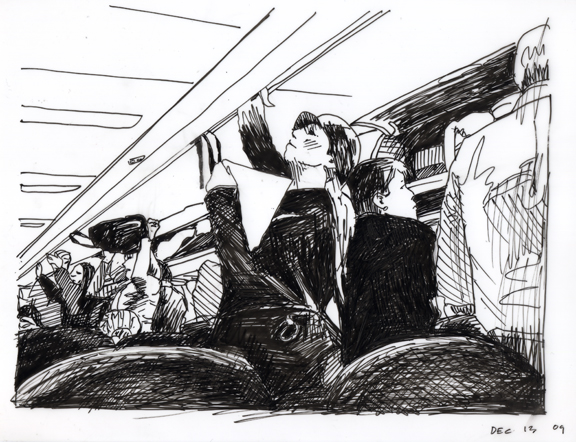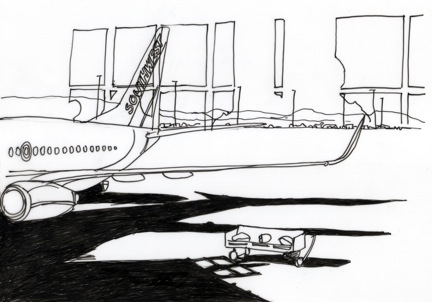INTERVIEW WITH DEBORAH ASCHHEIM

VIRALNET:
Viralnet.net asked artists to respond to the words 'home' and 'garden.'
We can frame the work of the moving image artists who chose to respond to 'home' as contemporary versions of 'home movies'...however there is something missing from the work of Ursula Brookbank, Nathan Ruyle and Elleni Sclavenitis to truly label them as home movies. The 'thing' that seems to be missing from their video work is a sense of nostalgia.
In Jeffery Ruoff's essay 'Home Movies of the Avant-Garde: Jonas Mekas and the New York Art World '...
Jeffery writes about how home movies were 'imbued with nostalgia' and contained a 'redemptive power of memory.' He also writes about the value of familiarity.
You also work with nostalgia and home movies in your sculptures. You talk about your work as 'a distillation of longing for the old future.'
At what point in your work do you cross the line from a familiar and private discourse with your images and materials into a public discourse about memory and the future?
ASCHHEIM:
I think one of my goals in working with my own family archive, at least initially, was to try to render myself incapable of anticipating the expectations of an audience, of pre-considering the work's public meaning before it was seen in public.
This passage from Ruoff's essay, quoting Howard Becker really resonated with me:
"Artists create their work, at least in part, by anticipating how other people will respond, emotionally and cognitively, to what they do. That gives them the means with which to shape it further, by catering to already existing dispositions in the audience, or by trying to train the audience to something new" (Becker 1982, 200).
That is how I was schooled as an artist, and in my case, early training in Anthropology further conditioned me to take an 'objective' approach to the experience of individual humans. I think when I was young it seemed somehow sophisticated to detach myself from my subject but as I got older I became suspicious of objectivity. My desire for it seemed dishonest, a cover for a deeper reluctance to reveal anything personal or emotional because it might seem sentimental, narcissistic...maudlin. That seemed timid to me. Somewhere around this time (ok, let's call it age "40") I had an ethical dilemma about continuing to conceal my private self, and I also started to question the assumption that I could ever understand what the experience of my work was for other people.
So, I started working with my grandfather's and my father's home movies and family photos. The only thing I thought I knew about audience regarding these images was that when I watched a 16mm clip of my grandma wearing her familiar clothes and performing her familiar gestures, walking into a room and kissing my dad, I wanted to burst into tears—and I was pretty sure a viewer would not, I thought they would just see a middle aged German lady and feel sort of bored. That was interesting to me, to deliberately work with images where my personal relationship to the subject drowned out my ability to see the images 'objectively.' Since I couldn't pretend to imagine what anyone else would experience, it also liberated me from feeling responsible for whether anyone else cared about what I was doing or thought it was important...until I started exhibiting the work, which was kind of terrifying at first.
The irony of working with nostalgic materials (maybe it is not a surprising result in retrospect, but it surprised me) turned out to be that often people are deeply moved by other people's artless personal images, and viewers came up to me all the time and told me about having experiences of 'mental time travel' where they re-experienced their own memories watching me and my sister playing in yellow sundresses, or they became very emotional during a sideshow of my grandparents' vacation.
When this started happening I had all sorts of theories—people are having an emotional response to the work because they are a certain age, they're Jewish/European and I have tapped into a shared story, there is something inherently mnemonic about the grain and color bias of Kodachrome and 16mm film stock. I even did an experiment with the Program in Cognitive and Affective Neuroscience at the University of Pittsburgh where we scanned subject's brains using functional magnetic resonance imaging (MRI) while they viewed their own and other's home movies to see what regions of the brain are activated when one experiences personally relevant versus not personally relevant memories. You can see more about it here: http://www.deborahaschheim.com/installations/on-memory/collaborations/brainscan/
Lately, my musician collaborator Lisa Mezzacappa and I have been working with the Apollo on boards—digitized versions of the 16mm home movies shot by the astronauts inside the command module on the space missions.
Here's a link to the public archive: http://www.nasaimages.org/.
We both had the experience of forming emotional attachments to the Apollo astronauts via their (public) home movies, which further confuses the whole issue—now when I see old photos of Alan Shepard or Rusty Schweickart, I miss them like I miss my grandparents.
VIRALNET:
Your 'reluctance to reveal anything personal' for fear of being sentimental and your ethical dilemma about concealing your private self seems to speak to Norman Klein's idea about what he calls 'the history of forgetting—' the erasure of our urban architecture, public space, culture and memory.' Your impulse seems to be the investigation of a personalized space; a space that presents us with familiar images and architecture stripped of their original context.
Norman Klein also states that 'the history of the last fifty years is increasingly about the crisis in representing space, from conceptual space to virtual space to cyberspace to cinematic space to public space to intimate space/identity.'
You seem to be acting as an interventionist (albeit a conceptual one) trying to conceal the original forms of the buildings through the use of the 'scaffolding' which ends up being a representation not of a memory of the original buildings, but a representation of an act that is meant to create a memory as you say, of an 'old future.'
How does erasure and concealment fit into your strategy of creating 'old futures?'
ASCHHEIM:
I thought for a long time about this question, as I spent the past few weeks shuffling between airports, coughing into my elbow (as we have been instructed) and washing my hands with antibacterial hand sanitizer because my sinus infection is, of course, our public health crisis.
The membranes that separate the inside of my body from the public space seem permeable, perhaps fictitious. Increasingly I find it hard to remember whether I have experienced something directly myself or secondhand via someone else's narrative or a machine-made digital experience. I think I experience Norman's crisis as a blurring of these boundaries between private and public space, and between bodies and buildings (and machines.)
In the analog age, erasure was palimpsestic—you rubbed something away and the trace where the thing was created an artifact. In the digital age, there's something ahistorical about erasure…we delete and undo and start a new version and save changes. I feel like the ghosts are still accumulating but they're more invisible somehow—they haunt us in a new way because it's hard to remember which mentally stored version of a space is the 'current' version'—I feel that every time I leave and return from a city I forget what has been torn down and what has been erected—I misplace my recent image and revert back to an obsolete version, I become disconnected in time.
The scaffolding is a strategy for making—crisis? displacement? the pixellation of time and space? the ghostliness of the hardscape world?—all visible. With my scaffolding, I'm trying to conceal and to create transparency that itself erases at the same time. When I move through the cities, scaffolding makes me remember the second law of thermodynamics—everything is always falling apart. Scaffolding appears to be a temporary support for some work in progress, but the buildings are never finished and the scaffolding never goes away. The scaffolding is like the physical embodiment of the mutability of everything, the fictitious nature of the past and the future, the mutability of memory itself. It's the barnacles on the pier, or kudzu, amyloid protein accumulating in your brain, digital files piling up on your hard drive. I could describe it better if I weren't so afflicted with it.
(that last sentence is borrowed from Donald Barthelme's story, "Brain Damage," from City Life, New York: Farrar, Straus (1970))
